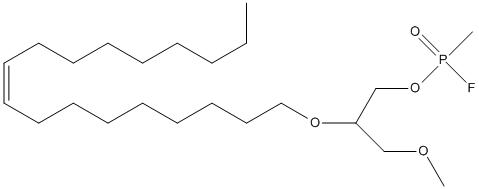O-3841
General
Type : Organophosphate,Lipase inhibitor
Chemical_Nomenclature : (Z)-1-[1-(fluoro-methyl-oxidophosphaniumyl)oxy-3-methoxypropan-2-yl]oxyoctadec-9-ene
Canonical SMILES : CCCCCCCCC=CCCCCCCCCOC(COC)CO[P+](C)([O-])F
InChI : InChI=1S\/C23H46FO4P\/c1-4-5-6-7-8-9-10-11-12-13-14-15-16-17-18-19-20-27-23(21-26-2)22-28-29(3,24)25\/h11-12,23H,4-10,13-22H2,1-3H3\/b12-11-
InChIKey : DEONOLSRIXDMGT-QXMHVHEDSA-N
Other name(s) :
MW : 436.6
Formula : C23H46FO4P
CAS_number :
PubChem : 102182137
UniChem : DEONOLSRIXDMGT-QXMHVHEDSA-N
IUPHAR :
Wikipedia :

Target
Families : O-3841 ligand of proteins in family: Lipase_3
Stucture :
Protein : human-DAGLA || human-DAGLB
References (2)
| Title : Assay and inhibition of diacylglycerol lipase activity - Johnston_2012_Bioorg.Med.Chem.Lett_22_4585 |
| Author(s) : Johnston M , Bhatt SR , Sikka S , Mercier RW , West JM , Makriyannis A , Gatley SJ , Duclos RI, Jr. |
| Ref : Bioorganic & Medicinal Chemistry Lett , 22 :4585 , 2012 |
| Abstract : Johnston_2012_Bioorg.Med.Chem.Lett_22_4585 |
| ESTHER : Johnston_2012_Bioorg.Med.Chem.Lett_22_4585 |
| PubMedSearch : Johnston_2012_Bioorg.Med.Chem.Lett_22_4585 |
| PubMedID: 22738638 |
| Title : Development of the first potent and specific inhibitors of endocannabinoid biosynthesis - Bisogno_2006_Biochim.Biophys.Acta_1761_205 |
| Author(s) : Bisogno T , Cascio MG , Saha B , Mahadevan A , Urbani P , Minassi A , Appendino G , Saturnino C , Martin B , Razdan R , Di Marzo V |
| Ref : Biochimica & Biophysica Acta , 1761 :205 , 2006 |
| Abstract : Bisogno_2006_Biochim.Biophys.Acta_1761_205 |
| ESTHER : Bisogno_2006_Biochim.Biophys.Acta_1761_205 |
| PubMedSearch : Bisogno_2006_Biochim.Biophys.Acta_1761_205 |
| PubMedID: 16466961 |
| Gene_locus related to this paper: human-DAGLA , human-DAGLB |